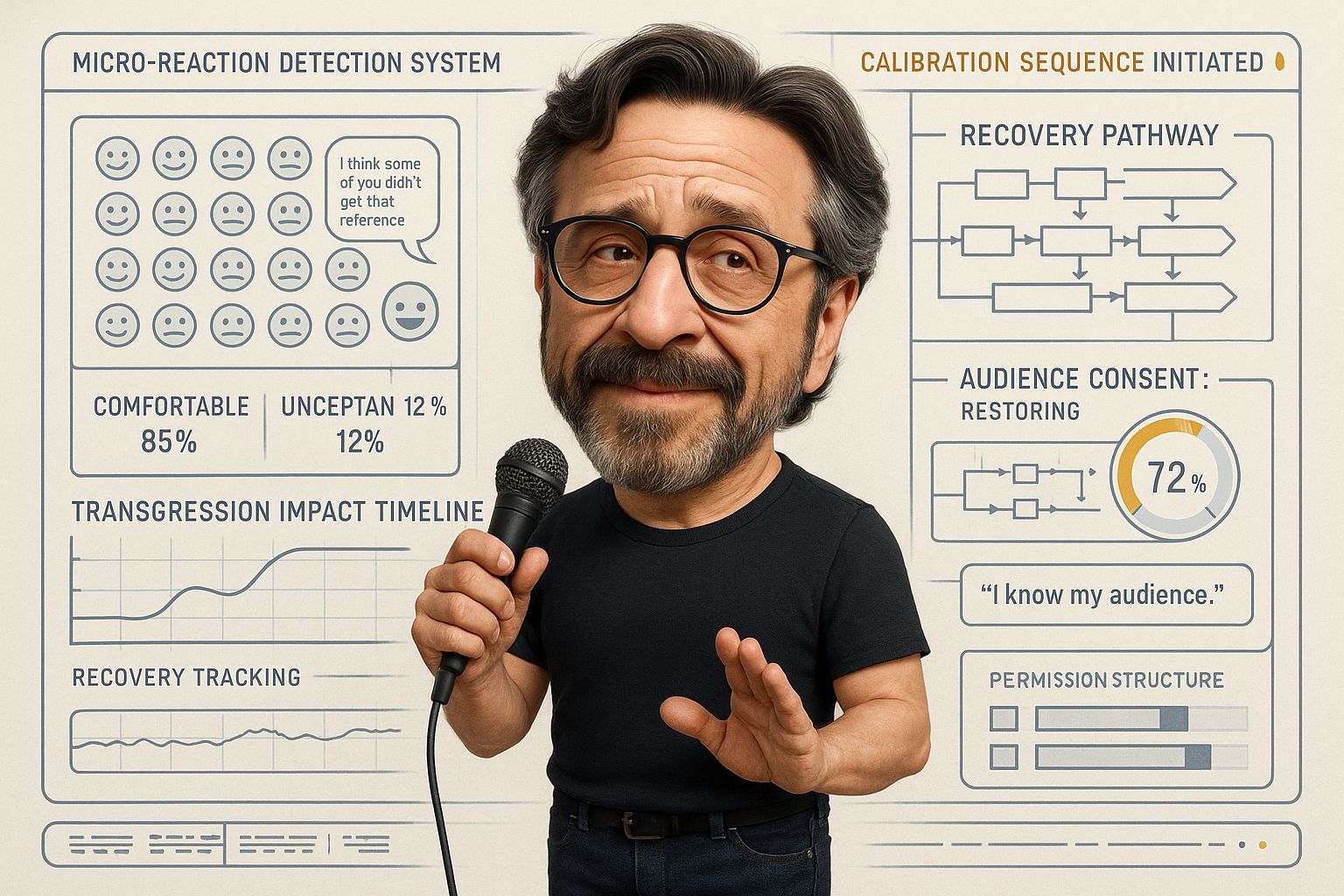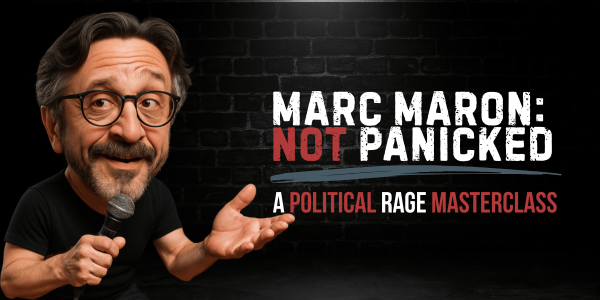Why This Bit
This opening six-minute sequence from Marc Maron's "Panicked" demonstrates masterclass-level risk management in politically charged material. Where lesser comedians stumble into partisan preaching, Maron constructs a surgical strike that neutralizes audience resistance through technical precision.
The segment operates on three mechanical levels: surface-level political commentary for immediate gratification, mid-level linguistic craftsmanship for comedy purists, and deep structural authority-building for long-term crowd control. Maron doesn't just deliver opinions—he engineers consent through calculated vulnerability and strategic self-awareness.
Most critically, this bit showcases advanced premise extension mechanics. Rather than burning through individual Trump jokes, Maron establishes a framework ("everything is great") that allows infinite expansion while maintaining comedic tension. This isn't accidental. It's architectural.

The Material
The foundational premise—"everything is great"—appears simple but functions as sophisticated misdirection. Maron opens with false enthusiasm: "I was a skeptic at first when he said he was gonna make everything great again, but, wow, I had no idea just how great it was gonna be."
Notice the syllable work. "Skeptic" (2 syllables) flows into "at first" (2 syllables), creating rhythmic consistency before the pause. The "but, wow" functions as a gear shift—harsh consonants followed by round vowel sounds that signal the turn. This isn't stream-of-consciousness. It's engineered cadence.
The character gallery that follows demonstrates premise extension mastery: "sociopathic huckster clown king," "autistic billionaire techno fascist," "actual Jewish Nazi." Each descriptor escalates through carefully calibrated absurdity. The progression isn't random—it moves from playground insults ("clown king") to clinical diagnosis ("sociopathic") to historical reference ("Nazi").
Maron then pivots to supporter categories: "army of shills and stooges and grifters, collaborators, unfuckable hate nerds." The alliteration in "shills and stooges" provides sonic satisfaction, while "unfuckable hate nerds" delivers the hard consonant punch that generates involuntary laughter.
The key maneuver: isolating the "I just like the guy" voters. This isn't political analysis—it's audience segmentation. Maron identifies the most psychologically vulnerable target: people without ideological armor.
Reading The Room
Maron demonstrates advanced crowd psychology by acknowledging his own transgression in real-time. After using the R-word, he immediately addresses audience discomfort: "I think some of you didn't get that reference, and also some of you are probably kind of still not over the fact that I actually said the R word."
This is risk management at its finest. Rather than doubling down or deflecting, Maron names the tension directly. The phrase "I know my audience" functions as both reassurance and threat—he's saying he understands their sensibilities while simultaneously declaring his intention to violate them.
The follow-up analysis—"Progressives have really got to figure out how to deal with this buzzkill problem"—is brilliant crowd manipulation. Maron positions himself as the reasonable progressive willing to critique his own side. This creates permission space for the audience to laugh at liberal stereotypes without feeling politically compromised.
The "barbecue" scenario that follows exploits this permission structure ruthlessly.
The Breakdown
Opening Authority Establishment (0:00-0:30) "So, uh, I'm great. Um… everything is great." The stammering ("uh," "Um") appears nervous but actually establishes intimacy. Maron's vocal texture—slightly gravelly, conversational—signals authenticity over performance. The repetition of "great" creates the comedic framework while the hesitant delivery makes the audience complicit in the setup.
Escalation Architecture (0:30-2:00) The descriptor sequence uses ascending aggression: "sociopathic huckster clown king" starts with clinical terminology, adds carnival imagery, then concludes with power dynamics. Each element serves specific psychological functions:
"Sociopathic": medical authority
"Huckster": nostalgic folksy insult
"Clown": visual absurdity
"King": power structure critique
Transition Logic (2:00-2:30) "And his supporters" functions as a bridge, but notice the pause placement. Maron lets the descriptor sink in before expanding the target. This isn't list-making—it's systematic demolition.
Risk Escalation (2:30-3:30) The R-word deployment represents advanced transgression mechanics. Maron builds to it through context layering: single-issue voters, free speech concerns, cultural pushback. By the time he reaches the slur, it's narratively earned rather than gratuitously deployed.
Recovery Protocol (3:30-4:00) The immediate acknowledgment ("I think some of you didn't get that reference") demonstrates professional-level audience monitoring. Maron reads micro-reactions and adjusts in real-time. This isn't apology—it's calibration.
Meta-Commentary (4:00-5:00) "Progressives have really got to figure out how to deal with this buzzkill problem" shifts the frame entirely. Maron moves from political comedian to cultural anthropologist, creating distance from his own material while maintaining comedic momentum.
Specificity Work (5:00-6:00) The barbecue scenario grounds abstract political tension in concrete social dynamics. "No one can ruin a barbecue quicker than a liberal" works because it's environmentally specific and behaviorally accurate.
What They Risked, How They Recovered
Maron risked alienating his core progressive audience through the R-word usage and liberal critique. The danger: appearing to validate conservative talking points about liberal sanctimony. Lesser comedians would either avoid the material entirely or lean into contrarian positioning.
Maron's recovery strategy: embedded critique within larger structural analysis. By positioning liberal buzzkill behavior as tactical error rather than moral failing, he maintains ideological credibility while acknowledging practical problems.
The soy milk tangent that follows serves as pressure release—moving from macro political dynamics to micro personal neuroses. This demonstrates advanced set construction: high-tension material followed by intimate confession.
The recovery also relies on Maron's established persona. His neurotic, self-aware character provides cover for provocative positions. The audience knows he's not actually conservative—he's just intellectually honest about progressive weaknesses.
The Closer
The sequence concludes with the soy milk story, which appears tangential but actually reinforces the political material's central thesis: liberal purity culture creates impossible standards. Maron can't even drink soy milk without receiving corrective emails about corporate ethics.
This ending works because it transforms abstract political criticism into lived personal experience. Rather than lecturing about progressive problems, Maron demonstrates them through autobiographical detail.
The transition into the next segment maintains the established framework while shifting focus. This is textbook premise extension—using the foundation to launch new material rather than abandoning successful structure.
Receipts
Technical execution: Masterclass-level premise construction with sophisticated risk management. Maron builds comedic frameworks that support extensive material while maintaining audience consent through strategic vulnerability.
Timing precision: Pause placement and syllable work demonstrate decades of stage experience. Every "uh" and "um" serves specific rhythmic functions.
Audience psychology: Advanced crowd manipulation through permission structure creation and real-time reaction monitoring.
This six-minute sequence represents comedy engineering at its finest—political material that acknowledges its own dangers while maintaining comedic integrity and ideological consistency.
Resources:
Comedian: Marc Maron
Special: Panicked (2025)



